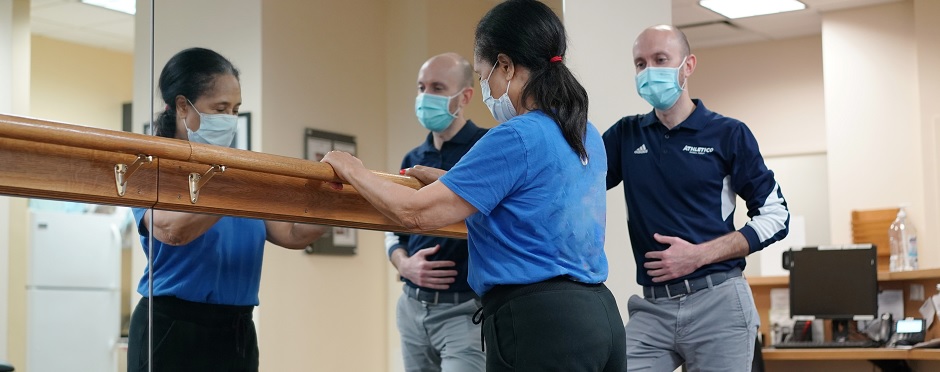
How PT Can Help Manage Long-Term COVID-19 Symptoms
Leave a CommentAs the vaccine combatting COVID-19 continues to be distributed, we await the days where we could potentially return to our normal world. Gathering in groups to eat at restaurants, attend sporting events and concerts, and go to work without masks. Until that day returns, we are still faced with the current pandemic as people you know or even yourself may have become infected with COVID-19. Some of the common symptoms include sore throat, cough, loss of taste and smell but COVID-19 has also been leaving individuals with long-lasting symptoms. We probably will not know the full long-term impacts of this virus until many years from now. However, there are many symptoms of the coronavirus present today, and it may surprise you to hear that physical therapy can help manage many of those.
COVID Effects within the Central Nervous System
One symptom of COVID-19 not discussed as often is dizziness and hearing loss. The scientific name of the new strain of the coronavirus is “severe acute respiratory syndrome coronavirus type 2” or “SARS CoV 2.”1 This virus can attach to receptors mainly in the lungs, hook onto the receptors, and replicate inside of the cells, which is why many symptoms of the virus present as respiratory.1 However, this is not the only area of the body in which these receptors are located. They are also found in the central nervous system, meaning the brain and spinal cord. Though this mechanism is less understood, this would allow the virus to possibly cause neurological symptoms. Two studies from Wuhan examined symptoms after COVID-19, and dizziness was found to be a symptom in 8% of post-COVID patients in one study and 16.8% of post-COVID patients in another study.2,3 If you feel as though you may have some of these lingering symptoms after having COVID-19, a physical therapist may be able to help you improve your balance through proprioceptive, visual, and vestibular treatment.
COVID Effects within the Respiratory System
Perhaps the most prominent of symptoms are those that result from COVID-19’s effects on the respiratory system. Severe respiratory reactions may result, which can impair breathing function, endurance and strength. One way in which physical therapists can help patients is by improving their breathing and creating strategies for patients who are fatigued. Diaphragmatic breathing is an exercise technique that physical therapists may train their patients on. This style of breathing allows for strengthening of the diaphragm muscle, which is a large muscle located at the base of the lungs. When working effectively, the diaphragm is the most efficient muscle for breathing, so if impaired after COVID-19, it may severely challenge your ability to breathe. Another strategy that therapists can teach their patient is paced breathing. Paced breathing is a technique that can be used during exercises or during functional movements throughout the day such as standing up or picking up objects from the floor. It is important that you take time to breathe before performing these activities. Your physical therapist can help you come up with strategies to decrease your fatigue during functional activity.
Patients who may have been on ventilators or needed prolonged hospitals stays may especially benefit from physical therapy to improve strength and endurance. Though the virus may not directly affect musculoskeletal strength, if you have been on bedrest, your muscles may have atrophied and you may find yourself to be much weaker than before you had the virus. In physical therapy, you will work on upper body, lower body, and core strength to improve your functional capacity. Additionally, endurance will be challenged with high repetitions of exercises, while keeping in mind paced breathing techniques to improve tolerance to these activities.
Physical Therapy Can Help You Return to An Active Life
Physical therapists are the experts that can help improve your balance, breathing function, endurance, and strength. If you or anyone you know had COVID-19 at any point during the last year and feel as though you may have residual symptoms, do not hesitate to schedule a free assessment with one of our therapists. Our therapists can perform a thorough evaluation to determine if physical therapy is right for you and design a unique exercise program to help you get back on your feet again. Free assessments are available in-clinic and virtually through our Telehealth service.
Physical therapy is usually the thing you are told to do after medication, x-rays or surgery. The best way to fix your pain is to start where you normally finish – with physical therapy at Athletico.
The Athletico blog is an educational resource written by Athletico employees. Athletico bloggers are licensed professionals who abide by the code of ethics outlined by their respective professional associations. The content published in blog posts represents the opinion of the individual author based on their expertise and experience. The content provided in this blog is for informational purposes only, does not constitute medical advice and should not be relied on for making personal health decisions.
Works Cited:
1. Cherchi, Marcello. “The New Coronavirus (SARS CoV 2) as a Cause of Dizziness or Hearing Loss in the COVID 19 Pandemic.” Covid-19 Otoneurology, 3 Sept. 2020, www.dizziness-and-balance.com/disorders/infections/covid19.html.
2. Chen, T., D. Wu, H. Chen, W. Yan, D. Yang, G. Chen, K. Ma, D. Xu, H. Yu, H. Wang, T. Wang, W. Guo, J. Chen, C. Ding, X. Zhang, J. Huang, M. Han, S. Li, X. Luo, J. Zhao and Q. Ning (2020). “Clinical characteristics of 113 deceased patients with coronavirus disease 2019: retrospective study.” BMJ 368: m1091
3. Mao, L., H. Jin, M. Wang, Y. Hu, S. Chen, Q. He, J. Chang, C. Hong, Y. Zhou, D. Wang, X. Miao, Y. Li and B. Hu (2020). “Neurologic Manifestations of Hospitalized Patients With Coronavirus Disease 2019 in Wuhan, China.” JAMA Neurol
